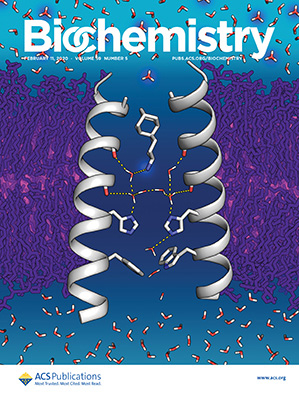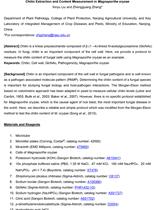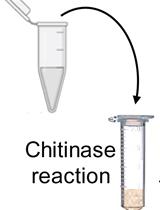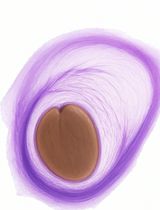- EN - English
- CN - 中文
Quantitative Characterization of the Amount and Length of (1,3)-β-D-glucan for Functional and Mechanistic Analysis of Fungal (1,3)-β-D-glucan Synthase
通过(1,3)-β-d-葡聚糖量和长度的定量表征对真菌(1,3)-β-d-葡聚糖合酶进行功能和机理分析
发布: 2021年04月20日第11卷第8期 DOI: 10.21769/BioProtoc.3995 浏览次数: 4698
评审: Alexandros Alexandratosdeepika jaiswalAnonymous reviewer(s)
Abstract
(1,3)-β-d-Glucan synthase (GS) is an essential enzyme for fungal cell wall biosynthesis that catalyzes the synthesis of (1,3)-β-d-glucan, a major and vital component of the cell wall. GS is a proven target of antifungal antibiotics including FDA-approved echinocandin derivatives; however, the function and mechanism of GS remain largely uncharacterized due to the absence of informative activity assays. Previously, a radioactive assay and reducing end modification have been used to characterize GS activity. The radioactive assay determines only the total amount of glucan formed through glucose incorporation and does not report the length of the polymers produced. The glucan length has been characterized by reducing end modification, but this method is unsuitable for mechanistic studies due to the very high detection limit of millimolar amounts and the labor intensiveness of the technique. Consequently, fundamental aspects of GS catalysis, such as the polymer length specificity, remain ambiguous. We have developed a size exclusion chromatography (SEC)-based method that allows detailed functional and mechanistic characterization of GS. The approach harnesses the pH-dependent solubility of (1,3)-β-d-glucan, where (1,3)-β-d-glucan forms water-soluble random coils under basic pH conditions, and can be analyzed by SEC using pulsed amperometric detection (PAD) and radioactivity counting (RC). This approach allows quantitative characterization of the total amount and length of glucan produced by GS with minimal workup and a d-glucose (Glc) detection limit of ~100 pmol. Consequently, this approach was successfully used for the kinetic characterization of GS, providing the first detailed mechanistic insight into GS catalysis. Due to its sensitivity, the assay is applicable to the characterization of GS from any fungi and can be adapted to study other polysaccharide synthases.
Keywords: (1,3)-β-D-Glucan synthase ((1,3)-β-D-葡聚糖合成酶)Background
Characterization of polysaccharides is fundamental to our understanding of various biological processes, such as cell wall biosynthesis in bacteria, fungi, and plants, biofilm formation by microbes, and the formation of extracellular matrix in humans. Although the characterization of short and soluble oligosaccharides can be performed using a variety of methods including thin-layer chromatography, high-performance liquid chromatography, and mass spectrometry, significant technical challenges remain with respect to the characterization of long, biologically relevant polymers. As a result, molecular details regarding the size and mechanism of biosynthesis of large polysaccharides remain mostly unknown.
Over the past two decades, many methods have been developed to study charged and water-soluble polysaccharides. For example, hyaluronan has been characterized using paper chromatography (Tlapak-Simmons et al., 2005) or electrophoresis (Krupa et al., 2007), and bacterial peptidoglycan has been characterized by electrophoresis (Barrett et al., 2007); however, few methods are available for the characterization of charge-neutral and water-insoluble polysaccharides. Among such polysaccharides, (1,3)-β-d-glucan is an essential structural component of the fungal cell wall (Munro, 2013), and its biosynthetic enzyme, (1,3)-β-d-glucan synthase (GS), is a proven target of FDA-approved antifungal antibiotics (Douglas, 2001). Thus, characterizing the mechanism of catalysis and inhibition of GS is imperative to understand fungal cell wall biosynthesis and the mechanism of action and resistance against GS-targeted antifungal drugs. However, despite GS activity having been known since the 1980s (Shematek et al., 1980), detailed mechanistic characterization has not been possible due to the absence of appropriate methods to quantitatively evaluate the amount and length of (1,3)-β-d-glucan. Consequently, many fundamental aspects of this enzyme, such as the product length specificity, remain ambiguous.
GS has been characterized using radioactive assays (Shematek et al., 1980) that quantitate the total amount of water-insoluble (1,3)-β-d-glucan by determining the amount of incorporated d-glucose (Glc). While this method determines the overall activity of GS, it does not reveal the length of the polymer products. The length of GS products has been characterized using reducing end modification (Shematek et al., 1980), where the reducing end of (1,3)-β-d-glucan is reduced to sorbitol and the polymer hydrolyzed to monosaccharides. Subsequently, the length is determined based on the ratio between Glc and sorbitol. This analysis suggests that the average length of (1,3)-β-d-glucan produced by GS in a crude membrane preparation is 60–80 mer (Shematek et al., 1980); however, this approach requires a large amount of (1,3)-β-d-glucan, usually in millimolar quantities. Moreover, the method can underestimate the length by cleavage via a peeling reaction or other mechanisms during the workup or purification (Chhetri et al., 2020); therefore, there currently exists no suitable method for the detailed mechanistic characterization of GS.
More recently, size exclusion chromatography (SEC) has been used to characterize the length of water-insoluble polysaccharides; however, the chromatography conditions and detection methods frequently limit its use in detailed mechanistic investigations. For example, fungal cell wall glucan and chitin were analyzed by SEC after carboxymethyl derivatization with monochloroacetic acid using radioactivity as the detection method (Cabib and Duran, 2005; Cabib, 2009). This chemical derivatization solubilizes otherwise water-insoluble glucan and chitin and allows SEC analysis using an aqueous solvent. However, since the derivatization is not quantitative, the absolute length of the polymers was not determined, and only the relative lengths of glucan- and chitin-containing isolated cell walls were determined (Cabib et al., 2012).
SEC has also been applied to characterize bacterial cellulose synthase. In this case, cellulose was solubilized in dimethylacetamide containing 8% LiCl (w/v) and analyzed by gel permeation chromatography coupled to multi-angle light scattering (GPC-MALS) (McManus et al., 2018). This approach avoids the pitfalls of chemical derivatization and is potentially applicable to many other polysaccharides. However, the length was determined only under the steady-state of enzyme catalysis, and elongation of the cellulose polymer was not detectable, likely due to the limited sensitivity of refractive index detection.
Here, we report the protocol used for the determination of the amount and length of (1,3)-β-d-glucan using SEC in aqueous sodium hydroxide with pulsed amperometric detection (PAD) and radioactivity counting (RC). This protocol overcomes the aforementioned limitations: PAD and RC allow the characterization of the length and distribution of glucan polymers at sensitivities appropriate for the mechanistic characterization of GS, and the use of aqueous sodium hydroxide as a solvent allows solubilization of the otherwise water-insoluble (1,3)-β-d-glucan. The detection limit of this approach (~100 pmol) is greater than four orders of magnitude lower than reducing end modification previously reported for (1,3)-β-d-glucan characterization. One important limitation of this assay is that it requires reasonably pure GS. So far, the method does not work with crude membrane fractions due to the presence of proteins that perturb the migration of glucan through the SEC column. Therefore, in this protocol, we describe both the preparation of partially purified GS using the product entrapment method and the SEC assay. The product entrapment yields GS with 20–30% purity on SDS-PAGE and a specific activity of ~1,000 nmol/min/mg. While our characterization suggests that the impurities in this preparation does not affect the apparent function of GS (either glucan length or kinetics) (Chhetri et al., 2020), it is critical to remove proteins from the glucan samples by washing with SDS. This protocol has been used to study the mechanism of GS catalysis and successfully detected (1,3)-β-d-glucan elongation between ~1,000 and ~8,000 mer for the first time in the over 40-year-long history of GS (Chhetri et al., 2020). The facile chain length determination was also coupled to blocked substrate analogs to unambiguously determine the direction of polymerization, one of the key but challenging mechanistic questions in polysaccharide biosynthesis (Chhetri et al., 2020). These applications demonstrate the significance of the SEC-based GS activity assays. Similar approaches could be adapted to study the activities of other polysaccharide synthases such as glycogen and hyaluronan synthases.
Materials and Reagents
50 ml Falcon tubes (VWR, catalog number: 89039-656)
70 ml polycarbonate bottle assembly, 38 × 102 mm (Beckman Coulter, catalog number: 355622)
3.5 ml open-top thick-wall polycarbonate ultracentrifuge tubes, 13 × 51 mm (Beckman Coulter, catalog number: 349622)
Acclaim SEC-1000 column 7 µm 4.6 × 300 mm (Thermo Fisher, catalog number: 079724)
Acclaim SEC-1000 Guard Column 7 µm 4.6 × 33 mm (Thermo Fisher, catalog number: 082739)
Trans-Blot Turbo RTA Transfer Kit LF PVDF (Bio-Rad, catalog number: 1704274)
MultiScreenHTS FC Filter Plate, 1.2/0.65 µm (Millipore Sigma, catalog number: MSFCN6B5)
MultiScreenHTS Vacuum Manifold (Millipore Sigma, catalog number: MSVMHTS00)
6” wood handle cotton swab (VWR, catalog number: 89031-270)
Peptic digest of animal tissue (Meat peptone; Criterion, catalog number: C7482)
Saccharomyces cerevisiae BY4741 (ATCC, catalog number: 201388)
Yeast extract (Criterion, catalog number: C7342)
d-Glucose (VWR, catalog number: BDH9230)
Agar (Acros, catalog number: 443570010)
0.5 mm glass beads (Scientific Industries, catalog number: SI-BG05)
Note: Prior to use, the glass beads should be cleaned with bleach, soaked overnight, and subsequently washed with deionized water until the pH of the water wash is neutral based on pH testing strips, usually after 10 washes. Finally, the beads should be washed twice with isopropanol and dried overnight.
Liquid nitrogen (Airgas, catalog number: NI 240LT22)
Ethylenediaminetetraacetic acid, proteomics grade (EDTA; VWR, catalog number: M101)
Sodium chloride (EMD Millipore, catalog number: SX0420-5)
Phenylmethylsulfonyl fluoride (PMSF; Acros Organics, catalog number: 215740100)
Tris base (Sigma, catalog number: T6066)
β-Mercaptoethanol (VWR, catalog number: M131)
Glycerol (EMD Millipore, catalog number: GX0185-6)
Pierce 660-nm Assay (Thermo Scientific, catalog number: 1861426)
EZQ Protein Quantitation Kit (Thermo Scientific, catalog number: R33200)
3-[(3-Cholamidopropyl)dimethylammonio]-1-propanesulfonate (CHAPS; VWR, catalog number: 0465)
Cholesteryl hemisuccinate Tris Salt (CHS; Anatrace, catalog number: CH210)
Dithiothreitol (DTT; VWR, catalog number: 97061-338)
Guanosine 5′-[γ-thio]triphosphate tetralithium salt (GTPγS; Sigma, catalog number: G8634)
4–20% Mini-PROTEAN TGX Stain-Free Protein Gels, 10 well, 50 µl (BioRad, catalog number: 4568094)
UDP-[U-14C]-d-Glucose (UDP-[14C]Glc; American Radioactive Chemicals, catalog number: ARC0154)
UDP-d-Glucose disodium salt (UDP-Glc; Carbosynth, catalog number: MU08960)
Sodium dodecyl sulfate (SDS; Sigma, catalog number: 75746)
Ethanol 190 proof (Koptec, catalog number: V1101)
Trichloroacetic acid (TCA; EMD Millipore, catalog number: TX1045)
50% (w/w) sodium hydroxide solution (NaOH; Fisher Chemical, catalog number: SS254-500)
ASTM Type I water (Ricca, catalog number: 9150-5)
Isopropanol (Fisher Chemical, catalog number: A416P).
Pullulan standard (Showa Denko K.K., catalog number: P-82)
Primary antibodies:
Anti-Fks1p (a gift from J.-P Latgé, Institut Pasteur) (Beauvais et al., 2001)
Anti-Rho1p (a gift from Y. Ohya, University of Tokyo) (Qadota et al., 1996)
Goat anti-rabbit IgG-HRP secondary antibody (Southern Biotech, catalog number: 4030-05)
Radiance HRP substrate for CCD imaging (Azure Biosystems, catalog number: AC2101)
Dionex ED electrochemical detector disposable electrodes, gold on PTFE (Thermo Fisher, catalog number: 066480)
40% sterile glucose solution (see Recipes)
Yeast Peptone Dextrose (YPD) media (see Recipes)
0.5 M EDTA stock, pH 8.0 (see Recipes)
Breaking Buffer (see Recipes)
Membrane Buffer (see Recipes)
KF Mix (see Recipes)
2× Assay Buffer (see Recipes)
Equipment
500 ml baffled flasks (Chemglass, catalog number: CLS-2044-05)
2.8 L baffled flasks (Chemglass, catalog number: CLS-2022)
-80°C freezer (VWR symphony Ultra-Low Temperature Freezer, model: DW-86L638H)
-20°C freezer (VWR, catalog number: 82027-388)
Tweezers (VWR, catalog number: 82027-388)
Magnetic stir bar (VWR, catalog number: 58948-98)
7 ml Dounce tissue grinder with type A and B pestles (Kimble, catalog number: D9063)
Sample pestle with a tube, 1.5 ml (Research Products International, catalog number: 199226)
Bead beater (Biospec, model: BeadBeater)
Type 45-Ti rotor (Beckman Coulter, model: 339160)
Beckman L7-55 Ultra-speed Centrifuge (Beckman, model: L7-55)
TLA 100.3 Fixed-Angle Rotor (Beckman Coulter, model: 349490)
Beckman Optima TL-100 Ultracentrifuge (Beckman, model: Optima TL-100)
Stir plate (Labnet Accuplate Analog Magnetic Stirrer, model: D0310)
BioVortexer (Biospec, model: 1083)
Water bath sonicator (NEY, model: ULTRAsonik 28H)
ICS-5000+ DC Chromatography/Detector System (Thermo Fisher, model: ICS-5000+)
Scintillation counter (Beckman Coulter, model: LS 6500)
Fraction collector (Pharmacia Biotech, model: FRAC-100)
Software
Microsoft Excel (Microsoft, https://www.microsoft.com/en-us/microsoft-365/excel)
Chromeleon 7.2 Thermo Scientific Dionex Chromeleon Chromatography Data System (Thermo Fisher Scientific, https://www.thermofisher.com/order/catalog/product/CHROMELEON7#/CHROMELEON7)
Procedure
文章信息
版权信息
© 2021 The Authors; exclusive licensee Bio-protocol LLC.
如何引用
Chhetri, A., Loksztejn, A. and Yokoyama, K. (2021). Quantitative Characterization of the Amount and Length of (1,3)-β-D-glucan for Functional and Mechanistic Analysis of Fungal (1,3)-β-D-glucan Synthase. Bio-protocol 11(8): e3995. DOI: 10.21769/BioProtoc.3995.
分类
生物化学 > 糖类 > 多糖
您对这篇实验方法有问题吗?
在此处发布您的问题,我们将邀请本文作者来回答。同时,我们会将您的问题发布到Bio-protocol Exchange,以便寻求社区成员的帮助。
Share
Bluesky
X
Copy link













